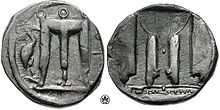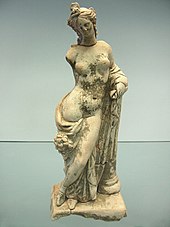Crotone
| Crotone | ||
|---|---|---|

|
|
|
| Country | Italy | |
| region | Calabria | |
| province | Crotone (KR) | |
| Coordinates | 39 ° 5 ' N , 17 ° 7' E | |
| height | 8 m slm | |
| surface | 179.8 km² | |
| Residents | 62,449 (Dec 31, 2019) | |
| Population density | 347 inhabitants / km² | |
| Factions | Papanice , Apriglianello, Carpentieri, Cipolla, Farina, Gabella Grande, Iannello, Maiorano, Margherita | |
| Post Code | 88900 | |
| prefix | 0962 | |
| ISTAT number | 101010 | |
| Popular name | Crotonesi | |
| Patron saint | San Dionigi (October 9th) | |
| Website | Crotone | |
Crotone (in ancient times Croton ) is an Italian commune with 62,449 inhabitants (as of December 31, 2019) and the capital of the province of Crotone . It lies in the region of Calabria on the Ionian Sea near the Gulf of Taranto .
Location and dates
The city, which had around 60,000 inhabitants in 1992, is divided into the districts of Papanice , Apriglianello, Carpentieri, Cipolla, Farina, Gabella Grande, Iannello, Maiorano and Margherita.
Its neighboring municipalities are Cutro , Isola di Capo Rizzuto , Rocca di Neto , Scandale and Strongoli .
history
prehistory
Since the middle Bronze Age (from the 15th / 14th century BC) there was a settlement on the soil of today's Crotone - possibly initially formed from several villages that grew together later. Excavations have unearthed different layers , which prove that the settlement existed until the early Iron Age (9th / 8th century BC). Fragments of Mycenaean pottery , which are also important for dating individual settlement phases, testify to contacts with Greece in the 13th and 12th centuries BC. Chr. (Pottery of the time stages SH III B and III C). Furthermore, in addition to clearly indigenous artifacts , there were also vessels that are classified as pseudominy ceramic .
Greco-Roman antiquity
According to Greek mythology , the city was founded by Alemon's son Myskelos on the grave of the late hero Croton.
The ancient croton was made at the end of the 8th century BC. Founded by Achaean Greeks near today's city center and developed into a rich polis . It was part of the so-called Magna Graecia . 12 kilometers southeast of Croton is the headland of Capo Colonna , the ancient Lakinion with its Hera shrine , known as the meeting place of the Italiotischen Bund , a union of the Greek cities against the Italians . In Croton, the famous Zeuxis is said to have created a portrait of Helena , the ideal image of female beauty, in the temple of Hera by taking the five most beautiful virgins as models, because perfect beauty does not occur in a single person in nature. Many famous athletes of the ancient Olympic Games , including the famous wrestler Milon , were from Croton. Around 530 BC BC the philosopher Pythagoras settled in Croton and founded the community of Pythagoreans . Already in the 5th century BC The medical school of Croton was very famous; as early as the late 6th century BC BC Demokedes , who came from Croton and was also the personal physician of Polykrates , was one of the most prominent physicians of the Greek culture. Diodorus reports that there was stasis in the polis in 318/17 , during which numerous citizens who had been banished from the city by their enemies were killed in an attempt to forcibly take Croton. The city finally came under control in 277 BC In the course of the Pyrrhic War under Roman rule. She had suffered great devastation.
Croton was little affected by the First Punic War . Around 215 BC The city probably had more than 2000 inhabitants. Meanwhile the Second Punic War had begun. When, after the Roman defeat in the Battle of Cannae (216 BC), the Bruttians and Lucanians passed over to the Carthaginians , the Greeks initially still held on to the alliance with the Romans. The people would have liked to change rulership, but the nobility's interests were linked to the Romans. In the meantime, Kroton was forcibly annexed by the grossers, who conquered the city with the exception of the castle. The Optimates stayed in the castle for a while, but then had to capitulate and move to Locri . In contrast, Croton received gross colonists, which further depressed the Greek element of the city. Towards the end of the war, when Hannibal lost more and more terrain and had to limit himself to the defensive in Bruttium, Kroton was one of the main bases of the Punic army because of its favorable location by the sea. So it was at the center of the war and suffered much again. To strengthen his position, Hannibal had 2500 Carthaginian Thurians resettled in the depopulated city.
When Kroton was now his headquarters, Hannibal erected a bilingual inscription in the temple of Hera Lakinia , a description of his deeds that the historian Polybius saw a few decades later, but only a small part of it, which the troop strengths of the Punic army in Spain and Listed Libya at the beginning of the war. The inscription was probably made in 70 BC. Destroyed when the sanctuary was sacked by pirates . When Hannibal Italy 202 BC. The Greek cities, including Croton, were nominally forgiven. However, the city had to cede a strip of arable land that was used in 194 BC Was distributed to Roman veterans. Gradually, the city lost its Greek character and also lost its economic relevance, only the port remained important.
Middle Ages and Modern Times
In 982 Emperor Otto II was defeated by the Saracens in the battle of Cape Colonna near Crotone.
After the Battle of Civitate , Crotone was captured by the Normans . With the Norman Empire, Crotone also fell to the Hohenstaufen in 1194 . From 1282 to 1860 Crotone belonged to the Kingdom of Naples or the Kingdom of the Two Sicilies . Yet the kings were far away; as their feudal lords , noble families exercised almost unlimited power, so in Crotone and its surrounding area, in the so-called Margraviate of Crotone (Marchesato di Crotone or Marchesato crotonese), the Ruffo family since 1390 .
In 1992 the province of Crotone was separated from the province of Catanzaro .
economy
Crotone, which has a port, is a trading center for agricultural products. There are also chemical factories . The city's outstanding buildings include a cathedral and castle from the 16th century. Crotone is on the Taranto – Reggio di Calabria railway line and has an airport ( Aeroporto S. Anna di Crotone ) .
Attractions
- Crotone Cathedral with a Byzantine Madonna
- Fort
- Museo Archeologico Nazionale di Crotone
- Stadio Ezio Scida ( FC Crotone Stadium )
Town twinning
Personalities
- Pythagoras (around 570 BC – after 510 BC), Greek philosopher
- Milon (around 555 BC – after 510 BC), Greek wrestler
- Alkmaion of Croton (second half of the 6th century - early 5th century BC), Greek natural philosopher
- Astylos of Croton (5th century BC), Greek runner
- Lino Patruno (* 1935), jazz musician, actor and composer
- Rino Gaetano (1950–1981), songwriter
- Carmine Abate (* 1954), writer and honorary citizen
- Vincenzo Iaquinta (* 1979), Italian football player
literature
- Fulvio Mazza (Ed.): Crotone. Storia, cultura, economia (= Le città della Calabria. Vol. 2). Rubbettino Editore, Soveria Mannelli 1992, ISBN 88-7284-121-6 .
- Andrea Pesavento: La città immaginaria. Crotone nel Viceregno dalla rinascita verso la crisi. Grafiche Basso, Bassano del Grappa 1985.
Web links
Individual evidence
- ↑ Statistiche demografiche ISTAT. Monthly population statistics of the Istituto Nazionale di Statistica , as of December 31 of 2019.
- ↑ In summary, the prehistory of Crotone: Marco Bettelli: Italia meridional e mondo Miceneo. Ricerche su dinamiche di acculturazione e aspetti archeologici, con particolare riferimento ai versanti adriatico e ionico della penisola italiana. , Florence 2002, p. 32.
- ^ Markwart Michler †: Western Greek medicine. In: Werner E. Gerabek , Bernhard D. Haage, Gundolf Keil , Wolfgang Wegner (eds.): Enzyklopädie Medizingeschichte. De Gruyter, Berlin / New York 2005, ISBN 3-11-015714-4 , pp. 1476-1482; here: pp. 1476–1478.
- ^ Ferdinand Peter Moog: Kroton, city. In: Werner E. Gerabek et al. (Ed.): Enzyklopädie Medizingeschichte. Berlin / New York 2005, p. 809 f.
- ↑ Titus Livius , Ab urbe condita 23, 30, 6; on this Gerhard Radke : Kroton. In: The Little Pauly (KlP). Volume 3, Stuttgart 1969, column 365.
- ^ Livius, Ab urbe condita 22, 61 and 24, 2 f.
- ↑ Polybios , Historíai 7, 1 and 10, 1; Livy, Ab urbe condita 23:30 ; 24, 2, 3; 26, 39, 7; 29, 18; 29, 36; 30, 19; Appian , Hannibalika 34; 51; 57.
- ↑ Polybios, Historíai 3.33; Livy, Ab urbe condita 28, 46, 16.
- ↑ Appian, Hannibalika 61.
- ↑ Livy, Ab urbe condita 34, 45, 4f.
- ↑ Andrea Pesavento: All origini della provincia di Crotone (as Nicola Ruffo, primo marchese di Crotone, all fallite Rivolte autonomistiche di Antonio Centelles). In: La Provincia KR. No. 1–7, 1996, online ( Memento from November 20, 2014 in the Internet Archive ).





